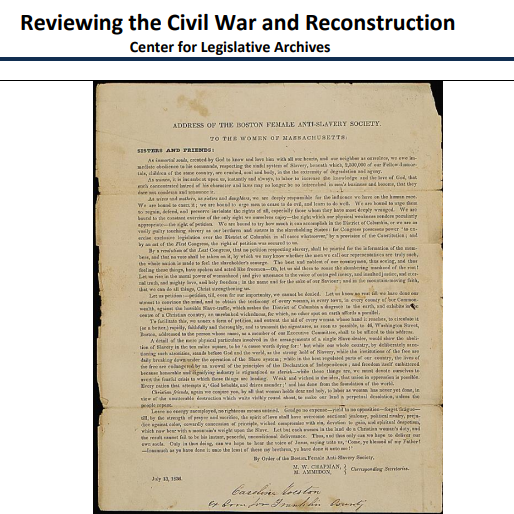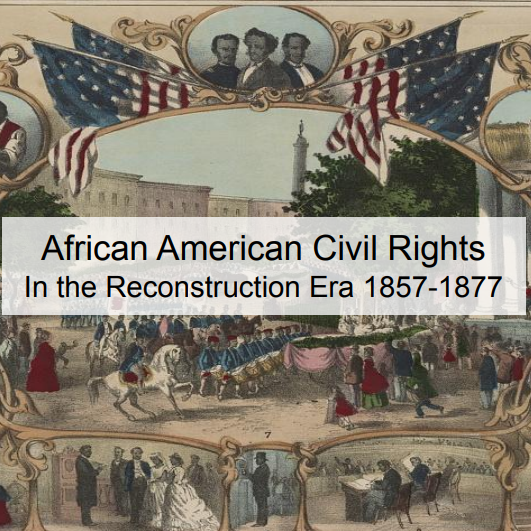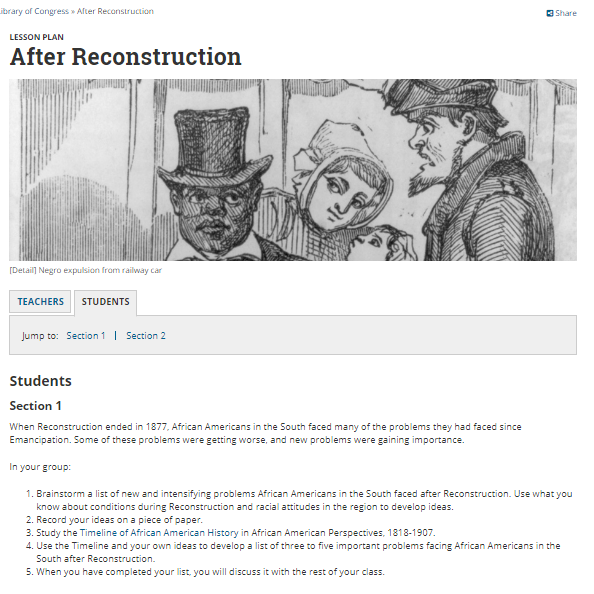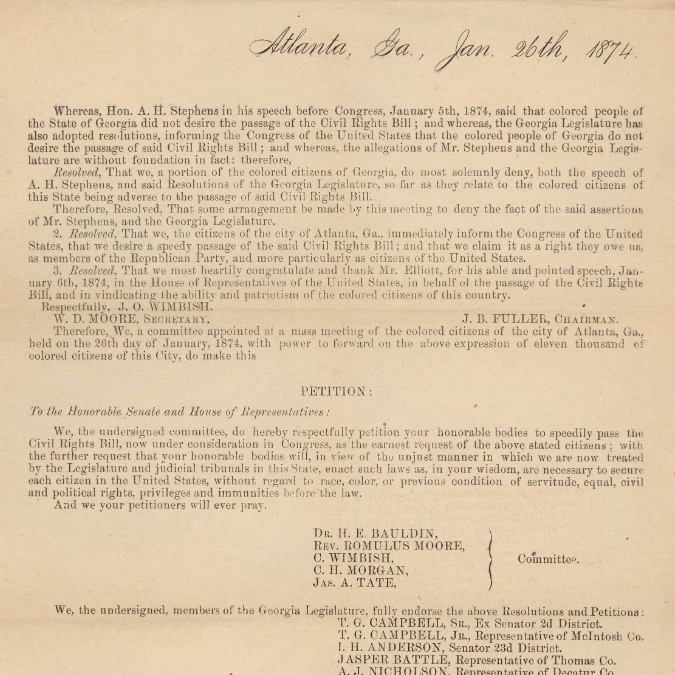Of, By, and For All People: Congress and the Fight against Racism in America
The journey towards an inclusive meaning of "we the people" has defined the American experiment in representative democracy since the immortalization of those words within the United States Constitution in 1787. For Black Americans, this journey has been defined by immense struggle and hardship, from ending the institution of slavery in the nineteenth century to the enduring fight for equality before the law that has lasted into our present age. The Legislative Branch has been a forum at the center of this debate since the first Congress convened in 1789. Over the summer of 2020, the Byrd Center initiated a series of programs and research to begin an exploration this historical journey, highlighting the role that the instruments and institutions of representative democracy have played in our national fight to become a more perfect union where the ideals of freedom, justice, and equality truly belong to everyone.
Programs to View:
These programs have been sponsored by the Robert C. Byrd Center for Congressional History and Education.
Slavery, Civil Rights, and the Gag Rule Debates in Congress
Abolitionist petitions to Congress in the 1830s touched off a protracted debate over slavery and civil liberties that roiled the U.S. Congress for nine years. The rise and fall of the 'Gag Rule' imposed upon abolitionist petitions and charts the wider impact of this controversial measure on the American political landscape. The Gag Rule debates quickened the development of a broad movement to defend civil liberties against the encroachments of the "Slave Power" that seemed to dominate the federal government. But by embracing this position, many activists fell short of the egalitarian values and goals espoused by the abolitionist petitioners themselves. Careful attention to the fruitful but complex relationship between moderates and radical abolitionists thus raises broader questions about the achievements and limitations of American antislavery politics.
|
|
To March Ahead of His Followers: Charles Sumner and the Civil Rights Act of 1875
Charles Sumner—Massachusetts senator and ardent abolitionist—gained fame in 1856 when he suffered a brutal beating in the Senate Chamber, an attack by a pro-slavery Representative who objected to one of Sumner’s fiery anti-slavery speeches. That dramatic story is found in history textbooks and recalled on Capitol tours, but it is just one chapter in the long and remarkable career of Charles Sumner. What came after the caning—Sumner’s tireless efforts to end racial inequality and pass a monumental civil rights bill—is his true legacy.
|
|
No Innocent Bystanders: The Power and Responsibility of Local Action
In February 1960, the Greensboro, NC sit-in movement rapidly spread throughout the South and also launched sympathy boycotts and sit-ins in northern communities, including New York City. Although in Manhattan lunch counters were not segregated, activists there immediately began picketing Woolworths and other stores throughout the greater metropolitan region. Southern activists used this northern work as leverage, and eventually many of the national chain stores reversed their Southern segregation policies. Over the next few years New York activists expanded their support for campaigns outside their community. They raised funds, sent volunteers, gathered reports, and held demonstrations against employment discrimination, disfranchisement, police brutality, racial violence, and residential segregation throughout the nation. These problems existed in their own city, too, and they believed fighting for racial justice in other parts of the country helped their local struggle, and vice versa. In other words, they considered “the movement” as national, and even international, in scope. Black New Yorkers’ hope for a broad-based movement extending beyond their city limits was hardly unique, and like activists in other communities they believed they could act locally and nationally at the same time. This talk explores the ways in which Black New Yorkers in the early 1960s used the advantages of their location to help cultivate a national black freedom movement.
|
|
The Bill of the Century: The Epic Battle for the Civil Rights Act
The Civil Rights Act of 1964 was the single most important piece of legislation passed by Congress in American history. This one law so dramatically altered American society that, looking back, it seems preordained-as Everett Dirksen, the GOP leader in the Senate and a key supporter of the bill, said, “no force is more powerful than an idea whose time has come.” But there was nothing predestined about the victory: a phalanx of powerful senators, pledging to “fight to the death” for segregation, launched the longest filibuster in American history to defeat it.
|
|
From the War on Poverty to the War on Crime
In the United States today, one in every 31 adults is under some form of penal control, including one in eleven African American men. How did the “land of the free” become the home of the world’s largest prison system? Challenging the belief that America’s prison problem originated with the Reagan administration’s War on Drugs, this program traces the rise of mass incarceration to an ironic source: the social welfare programs of Lyndon Johnson’s Great Society at the height of the civil rights era.
|
|
“The Shame of America”: The New Deal Senate and the Federal Anti-Lynching Bill
In the decades between the Civil War and World War II lynch mobs murdered more than 4,700 Americans. Three-quarters of those victims were African American. In 1934, Senate progressives, working closely with racial justice advocates, introduced a bill to make lynching a federal crime. A majority of senators supported the bill—as did the public at large—but after months, and then years of debate, the Senate failed to approve it. This dramatic, at times shameful, chapter in the nation’s history illustrates the limits of progressive reform during the New Deal era.
Vanguard: How Black Women Broke Barriers, Won the Vote, and Insisted on Equality for All with Martha S. Jones
In the standard story, the suffrage crusade began in Seneca Falls in 1848 and ended with the ratification of the Nineteenth Amendment in 1920. But this overwhelmingly white women’s movement did not win the vote for most black women. Securing their rights required a movement of their own.
Vanguard is a new history of African American women’s political lives in America. She recounts how they defied both racism and sexism to fight for the ballot, and how they wielded political power to secure the equality and dignity of all persons. From the earliest days of the republic to the passage of the 1965 Voting Rights Act and beyond, Jones excavates the lives and work of black women — Maria Stewart, Frances Ellen Watkins Harper, Fannie Lou Hamer, and more — who were the vanguard of women’s rights, calling on America to realize its best ideals.
Vanguard is a new history of African American women’s political lives in America. She recounts how they defied both racism and sexism to fight for the ballot, and how they wielded political power to secure the equality and dignity of all persons. From the earliest days of the republic to the passage of the 1965 Voting Rights Act and beyond, Jones excavates the lives and work of black women — Maria Stewart, Frances Ellen Watkins Harper, Fannie Lou Hamer, and more — who were the vanguard of women’s rights, calling on America to realize its best ideals.
Educational Resources:
A selection of educational resources, archival documents, and lesson plans for exploring the struggle for African American Civil Rights from the Byrd Center as well as the National Archives and Records Administration and the Library of Congress. These lesson plans are designed for secondary level students and are applicable in civics, history, social studies, or government courses of instruction.
Reviewing the Civil War and ReconstructionIn this lesson students will analyze primary sources to review major issues related to the Civil War, Reconstruction, and Civil Rights. (From the National Archives and Records Administration)
|
African American Civil Rights in the Reconstruction Era 1857-1877How are Civil Rights created and protected in America? This lesson explores this question in the context of African American Civil Rights won in the Reconstruction Era. (A slide presentation is available) (From the Byrd Center)
|
After ReconstructionWhen Reconstruction ended in 1877, African Americans in the South faced many of the problems they had faced since Emancipation. Some of these problems were getting worse, and new problems were gaining importance. (From the Library of Congress)
|
Was Reconstruction a Revolution?Students will examine several historical congressional records from the Reconstruction period to assess whether the documents show evidence that the Reconstruction period of American history should or should not be viewed as a revolution. (From the National Archives)
|
Our Mission: |
The Byrd Center advances representative democracy by promoting a better understanding of the United States Congress and the Constitution through programs and research that engage citizens.
|
Copyright © Robert C. Byrd Center for Congressional History and Education
|





